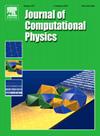MOOSE-based finite element framework for mass-conserving two-phase flow simulations on adaptive grids using the diffuse interface approach and a Lagrange multiplier
IF 3.8
2区 物理与天体物理
Q2 COMPUTER SCIENCE, INTERDISCIPLINARY APPLICATIONS
引用次数: 0
Abstract
A numerical framework capable of simulating incompressible laminar two-phase flows has been developed within the Multiphysics Object-Oriented Simulation Environment (MOOSE). The fully-coupled and fully-implicit-in-time methodology relies on the continuous Galerkin finite element discretization of the coupled Cahn-Hilliard Navier-Stokes (CHNS) equations. Despite the computational advantages of adaptive mesh refinement (AMR), mass-conserving interpolation schemes do not exist for transferring the solution to a newly adapted mesh. This paper introduces a new time-dependent scalar Lagrange multiplier to ensure mass conservation on adaptive grids while efficiently handling the interpolation errors involved in mesh coarsening. To assess the accuracy of the numerical implementation, several two-phase flow benchmark problems have been studied and validated against reference solutions. The comparisons demonstrate the accuracy of the code and the overall methodology. The proposed method can be effectively applied to any 2D, 2D axisymmetric and 3D complex immiscible two-phase flows, leveraging conservative AMR without compromising conservation principles.

求助全文
约1分钟内获得全文
求助全文
来源期刊

Journal of Computational Physics
物理-计算机:跨学科应用
CiteScore
7.60
自引率
14.60%
发文量
763
审稿时长
5.8 months
期刊介绍:
Journal of Computational Physics thoroughly treats the computational aspects of physical problems, presenting techniques for the numerical solution of mathematical equations arising in all areas of physics. The journal seeks to emphasize methods that cross disciplinary boundaries.
The Journal of Computational Physics also publishes short notes of 4 pages or less (including figures, tables, and references but excluding title pages). Letters to the Editor commenting on articles already published in this Journal will also be considered. Neither notes nor letters should have an abstract.
 求助内容:
求助内容: 应助结果提醒方式:
应助结果提醒方式:


